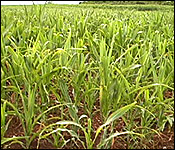
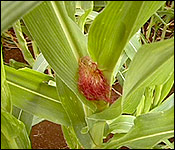
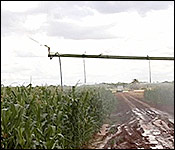
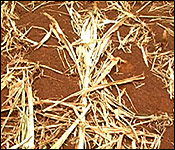 You might not have noticed it, but this year's rainy season has been very dry. The farmers of the southern Orange Walk District are acutely aware of the shortage of rain - in fact they say a drought is crippling their corn harvest and causing losses in earnings that could add up to millions of dollars. Not only that, but it could also cause the price of food to go up - and we don't just mean corn tortillas! We found out more when we visited the area of Indian Creek in the Orange Walk District today. The area is home to a co-op of 141 members - and they are losing vast acreages of cornfields due to drought. Here's more:...
You might not have noticed it, but this year's rainy season has been very dry. The farmers of the southern Orange Walk District are acutely aware of the shortage of rain - in fact they say a drought is crippling their corn harvest and causing losses in earnings that could add up to millions of dollars. Not only that, but it could also cause the price of food to go up - and we don't just mean corn tortillas! We found out more when we visited the area of Indian Creek in the Orange Walk District today. The area is home to a co-op of 141 members - and they are losing vast acreages of cornfields due to drought. Here's more:...
Jacob Harms, CEO - Indian Creek Co-Op
"I have been doing farming for myself. I've been farming for 26 years now and we have never seen that kind of drought what we have now."
Jules Vasquez reporting
Jacob Harms says that in a lifetime of farming - he has never seen anything quite like this.
They've experienced a drought for three of the last four years - and the losses are adding up in the corn field:
Jacob Harms
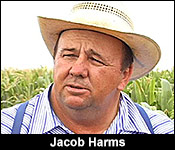 "Usually we're getting good rain. It starts in May and then in June. In July, it's usually a little bit dry but not much. That's what is happening. From 2012 we saw that we had no rain. On the 2013 we had good rain and we had good water on that and then the 2014 we lost about everything. Now its 2015 and now it looks like we are going to lose again."
"Usually we're getting good rain. It starts in May and then in June. In July, it's usually a little bit dry but not much. That's what is happening. From 2012 we saw that we had no rain. On the 2013 we had good rain and we had good water on that and then the 2014 we lost about everything. Now its 2015 and now it looks like we are going to lose again."
This entire cornfield - 100 acres of it is no good - a total loss. At a cost of 600 to 700 dollars per acres - that's an economic loss of about 65 thousand dollars - on just this one field.
In 2014, they lost about 4 million dollars in earnings, and 2015 is looking even worse - with over three thousand acres of corn fields about to be written off.
This field is one of them - the 90 acres never reached maturity - because it never got rain. To the untrained eye the corn stalks may look healthy - but the plant's growth has been stunted, there is the male tassel with pollen but no female part - the hair at the bottom - which should look like this - but is nonexistent in this field.
Jacob Harms
"Yeah this is a complete write-off. Is somebody passing says, yes they could still get a little percentage, but if you really look on this corn is too late. They are supposed to have green corn already and there's nothing here yet so we see that there is nothing. So this corn has lost totally, this corn is zero percent."
Eventually, this field - all these rows of corn - will have to be cleared, and it will look like this thousands of stalks flattened.
But, all is not lost - these are healthy stalks of corn - and there are acres and acres of it. The difference is, these got irrigated - seems simple enough. But a rig like this costs hundreds of thousands of dollars.
Hon. Jose Mai, Area Representative - OW South
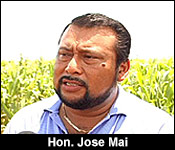 "And I recall when the farmer imported this irrigation systems, because we had to try to mitigate the effects of climate changed. So they are looking at it, studying the situation and investing in irrigation equipment and when we get to the borderline they tell them that they have to pay the GST. And then you say but hold on and you look at the items and it's that the irrigation equipment is zero rated. So why are they charging? And they well he will get it back. Well, the policy for that is 90 days, but it doesn't happen that way. Blue Creek right now has owed GST for 3 years now."
"And I recall when the farmer imported this irrigation systems, because we had to try to mitigate the effects of climate changed. So they are looking at it, studying the situation and investing in irrigation equipment and when we get to the borderline they tell them that they have to pay the GST. And then you say but hold on and you look at the items and it's that the irrigation equipment is zero rated. So why are they charging? And they well he will get it back. Well, the policy for that is 90 days, but it doesn't happen that way. Blue Creek right now has owed GST for 3 years now."
And the irrigation only goes so far - in this field the irrigated and the rain fed stand juxtaposed, from a sickly yellow green to a lush verdant green
Jacob Harms
"You're seeing here where we have irrigated and where is non-irrigated. you see that we have in front to my right hand, you see its non-irrigated and if you look into this railroad right here and you'll see the greenish, that's irrigated and that's where you see where we are going to make some profit on."
But, it's not going to be enough and, because of that, this year, corn prices are probably going up - which also means food prices will go up while food security goes down:
Jacob Harms
"Right now since there's a shortage on corn. The corn used to run from around 22 to 25 cents a pound. Right now the corn runs from 30 to 37 cents a pound. That's only because of the shortage. As we see the drought that is passing now, that's what we are seeing that it runs short and that's what raise the price and the chicken price will go up, the eggs will go up, everything goes up. So that will cost more for everybody. We must work on something that goes better."
Hon. Jose Mai, Area Representative - OW South
"Well my constituency is the main grain producing area. I think that the impact is national. First and foremost, situations like these are what cause the food price to be increased. So we have to be very careful. If we have a population that has 44% poverty and this only contributes further to such poverty status."
Jacob Harms
"So far that I know we are the only country in Central America that have our own grains. That's soy bean, corn, beans all of that. I think Belize is the only country in this area. So we will not survive if there's nothing. We need a change. We need something."
And if you're looking for a culprit - it could be climate change:
Jules Vasquez
"Is this all a product of climate change?"
Jacob Harms
"I don't know what to say on that exactly. It looks like the cause of climate change but this is something that we never suspect so far. We don't know what it is exactly."
But they do know that they need help:
Hon. Jose Mai, Area Representative - OW South
"See these farmers don't have sacks of money under their bed. That they wake up one day and ploy, harrow and buy fertilizer and buy seeds. These people have to borrow money. They borrow money at some very high rates."
Jules Vasquez
"If it continues like this..."
Jacob Harms
"The farmers are not surviving. They cannot survive on that. There is no benefit or profit on the corn for that."
Jules Vasquez
"So then, foreseeably you all would have to stop growing corn in Indian Church?"
Jacob Harms
"Yes, we would have to stop growing corn in Indian Creek or we need to put in an irrigation system. We need to make a huge change, but we are not yet down with what we are going to do. Maybe we will find a solution somewhere. We don't yet what is going to happen but yes we have to stop. We cannot continue going on."
Corn currently sells for between 25 and 30 cents per pound - but this year the figure could go up to as much as 37 cents per pound.



